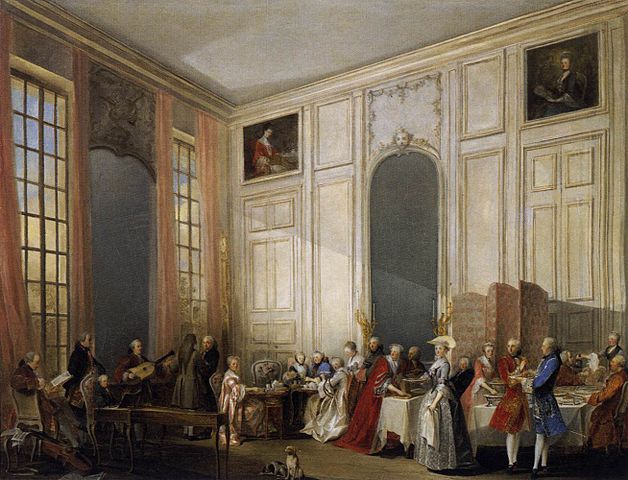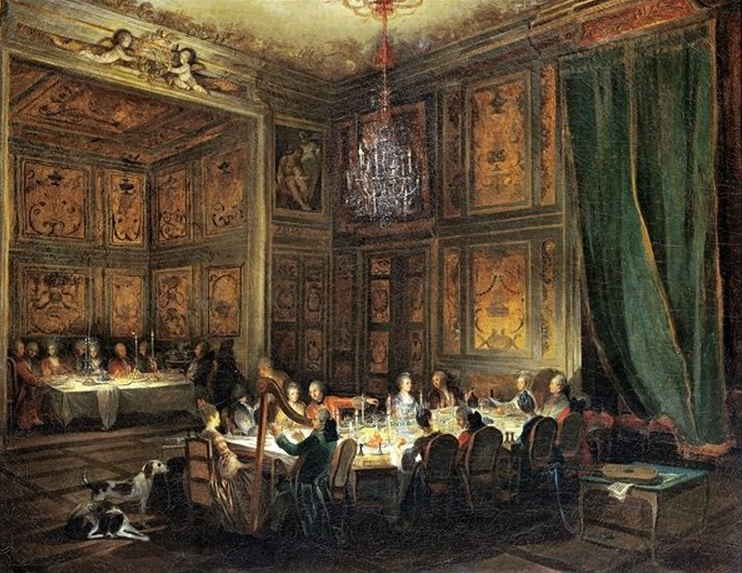 |
| Francois de Bourbon-Conde @Wikipedia |
(1558-1614)
Prince de Conti
1581-1614
Husband of:
1. Jeanne de Coesmes, Dame de Bonnetable et de Luce (d.1601) mar 1581
2. Louise-Marguerite de Lorraine (1558-1631) mar 1605.
His lover was:
Natural offspring:
1. Nicolas batard de Conti (d.1648), Abbe de Bassac.
Francois-Louis de Bourbon, Prince de Conti (1664-1709)
His lover was:
Lover in 1695.
His lovers were:
1) Angelique-Dorothee Babaud (1737-1805)
Lover in 1770.Marquise de Cassini.
French salonniere
Wife of: Dominique-Joseph Cassini mar 1754.
Marquise de Cassini's other lovers were:
Marquise de Cassini's other lovers were:
 |
| Jean, Marquis of Maillebois |
1) Jean-Baptiste-Francois Desmarets, Marquis de Maillebois (1682-1762)
French marshal
2) Goltz, Prussian Ambassador.
3) Yves-Marie Desmarets, Marquis de Maillebois.
2) Goltz, Prussian Ambassador.
3) Yves-Marie Desmarets, Marquis de Maillebois.
(1734-1814)
1776-1814
His lover was:
Italian-French actress.
Daughter of: Carlo Veronese, Pantalone actor.
Natural offspring:
Daughter of: Carlo Veronese, Pantalone actor.
Natural offspring:
1. Louis-Francois de Bourbon, Chevalier de Vaureal (1782-?)
Her other lover was:
Comte d'Egreville.
" . . . Veronese and his daughters did indeed make their debuts on the Paris stage at the Theatre des Italiens in May 1744. It was the beginnaing of an immensely successful career on the state na din society; and in a roundabout way, Rousseau's interest in the Veronese family was rewarded, for Coraline, before she crowned her career with a marriage to the Marquis de Silly, was for several years the mistress of the Prince de Conti, who was to protect Rousseau in a time of need." (Cranston: 179)
Prince de Conti |
Louis-Francois I de Bourbon, 6th Prince de Conti (1717-1776)
Husband of: Louise-Diane d'Orleans, Mademoiselle de Chartres. His cousin & daughter of Philippe, Duc d'Orleans& Francoise-Marie de Bourbon, mar 1731.
"Handsome, with a really royal mien, dignified manners, and a majestic and imposing presence, the Prince de Conti was affable, gracious, and at ease with everybody. e was called 'the last of the princes.' But his great qualities were marred by defective judgment, confusion of ideas, and an ambition which was not justified by superior intelligence. The Prince de Ligne has left this pleasing sketch of him: 'He is a composite of twenty or thirty men. He is proud, he is affable, ambitious, and a philosopher by turns; discontented, greedy, indolent, noble, and debauched; the idol and the model of good company, and only accepting bad company out of deliberately perverse profligacy, but with a great deal of self-respect in it too; gracious, eloquent, the handsomest and most majestic of men; with a manner and a style of his own; a good friend, frank, amiable, well informed . . . anxious to play a part, but lacking method of mind; anxious to be feared, and only succeeding in being loved ... fit for anything, and capable of nothing. So true is this, that his mother once said of him: 'My son is a very clever fellow. Oh! yes, very. But he is built like an obelisk, and diminishes towards the top, ending in a point line a spire.' Notwithstanding his moderate fortune, he ruined himself in generosity and gallantries. His entertainments at the Temple and at l'Isle-Adam have remained famous." (The Duc de Lauzun and the Court of Louis XV.: 121)
The Prince de Conti's Famous Entertainments.

Dinner of the Prince of Conti in the Temple
Michel Barthélemy Ollivier, 1766
Chateau de Versailles
Michel Barthélemy Ollivier, 1766
Chateau de Versailles
 |
Festival Given by the Prince of Conti to the Prince of Brunswick-Lunebourg at l'Isle-Adam by Michel Barthelemy Olivier, 1766. |

His lovers were:
1) Adrienne-Catherine de Noailles, Comtesse de Tesse.
" . . . In November or December 1763, Leopold noted in his journal: 'Prince Conti at the Temple.' Wolfgang became a familiar in the lofty salon, with with its green walls, rose hangings, white woodwork touched with gold, and glittering mirrors and sconces---exquisite surroundings in which his patroness and Conti's mistress, the Countess de Tesse, did the honors. . . ." (Gutman: 173)
" . . . In November or December 1763, Leopold noted in his journal: 'Prince Conti at the Temple.' Wolfgang became a familiar in the lofty salon, with with its green walls, rose hangings, white woodwork touched with gold, and glittering mirrors and sconces---exquisite surroundings in which his patroness and Conti's mistress, the Countess de Tesse, did the honors. . . ." (Gutman: 173)
.jpg%2F475px-Portrait_of_Barbara_Campanini_%27La_Barberina%27_(1721-1799).jpg&container=blogger&gadget=a&rewriteMime=image%2F*) |
| Barbara Campanini |
Italian ballet dancer.
Grafin von Barschau 1787; Contessa Campanini 1787.
Wife of:
1. Karl Ludwig, Freiherr von Cocceji, mar 1748, Sep 1759, div 1788
2. a German baron.
3) Louise-Jeanne de Durfort, Duchesse de Mazarin.
4) Marie-Anne-Louise Fontaine.
5) Madame Panneau d'Arty.
 |
| Marie-Charlotte Comtesse de Boufflers |
Marie-Charlotte-Hippolyte de Campet de Saujon
Lover in 1746.
Comtesse de Boufflers (1724-1800)
French lady of letters & salonniere.
Marquise de Boufflers-Rouveral (by marriage)
Lady-in-Waiting to the Duchesse de Chartres.
Daughter of: Charles-Francois de Saujon, Baron de la Rivere & Louise-Angelique de Barbering de Reignac.
Wife of: Edouard, Comte y Marquis de Boufflers-Rouverel (d.1763), A captain in the Bellefonds regiment, mar 1746.
Lover in 1746.
Comtesse de Boufflers (1724-1800)
French lady of letters & salonniere.
Marquise de Boufflers-Rouveral (by marriage)
Lady-in-Waiting to the Duchesse de Chartres.
Daughter of: Charles-Francois de Saujon, Baron de la Rivere & Louise-Angelique de Barbering de Reignac.
Wife of: Edouard, Comte y Marquis de Boufflers-Rouverel (d.1763), A captain in the Bellefonds regiment, mar 1746.
"A type of what may be called the social mistress of the nobility--the personification of good taste, elegance and propriety such as it should be--was the Comtesse de Boufflers, mistress of the Prince de Conti, intimate friend of Hume, Rousseau, and Gustav III, King of Sweden. The countess was one of the most influential and spirituelle members of French society, her special mission and delight being the introduction of foreign celebrities into French society. She piloted them, was their patroness, spoke almost all modern languages, and visited her friends in their respective countries. She was the most travelled and most hospitable of great French women, hence the woman best informed upon the world in general. "She was born in 1725, and in 1746 was married to the Comte de Boufflers-Rouvrel; soon after, becoming enamored of the Prince de Conti, she became his acknowledged mistress. . . ." (Women of Modern France)
" . . . Married in 1732 to Mademoiselle de Chartres, daughter of the Regent d'Orleans, he [Prince de Conti] ha had become a widower in 1736, and afterwards contracted a liaison with the celebrated Countess de Boufflers-Rouverel, whose first appearance at the Court of Versailles, according to a madrigal of the time, provoked the supposition that Cupid's mother had descended in person from Olympus. A woman of fascinating beauty, endowed with a lively and original wit, Madame de Boufflers was separated from her husband, and resided at the Hotel de St. Simon in the Rue Notre Dame de Nazareth, whence she every day repaired to the Temple to preside at the receptions which the Prince the Conti held there. . . ." (The True Story of the Chevalier D'Eon: 4)
"In 1746 she was married to Édouard de Boufflers-Rouverel, Comte de Boufflers. Having thus moved two steps up the hierarchical ladder Marie-Charlotte aimed for a life at court. It did not take long before Marie-Charlotte fell pregnant. She gave birth in 1746 to the couple's only child: a son. Soon, there was a position available to her. The newly married Comtesse de Boufflers was attached to the household of the Duchesse de Chartres as a dame du compagnie. In her capacity as companion to the Duchesse Marie-Charlotte lived at the Palais-Royal. Here, she met the Prince de Conti; the two became rather fond of each other and were soon known to be lovers. Marie-Charlotte could have continued her career at court quite unnoticed if it had not been for a disagreement with the house of Orléans. She was soon obliged to leave the Palais-Royal (which belonged to this branch of the Bourbon-house); instead, she purchased a small hôtel near the Grand Prior's palace. Two years later, she was once again in Paris." (This is Versailles)
 |
In 1765 her lover [Prince de Conti] granted her the Château de Stors.
Now she had a residence which suited one of her repute. However, she was never really attached to the court at Versailles. Perhaps the feud with the Orléans-clan made her a persona non grata. She had only travelled there upon the death of her father-in-law in 1750. Despite being well-known to the court she was not officially presented there until 1770. This time it was her new lover, the Marèchal de Luxembourg, who performed the introduction. Marie-Charlotte lost her husband in 1764; she had hoped to contract a new marriage to her long-term lover, the Prince de Conti. The match never materialized, though. Although the couple had remained lovers for years the Prince was not interested in making her his wife. Even if he had been so inclined it is likely that her "low-born" origins would have presented a difficulty. Perhaps this unfulfilled wish was what cooled their relationship; as stated, she had taken another lover by 1770. In 1773 she acquired another property - a country house at Auteuil. She would retire hereto in 1776 when the Prince de Conti died. Still, she kept her house in Paris as well. Her salon was still in full swing where she would meet influential people. The Comtesse de Boufflers had ties to the Swedish king and even arranged the marriage between the Swedish ambassador and Germaine Necker. Dividing her time between her salon in Paris and her estate at Auteuil - and several other properties - she kept herself busy. The advent of the French revolution brought a final end to her salon in 1789." (This is Versailles)
7) Marie-Claude Gacher-Dailly, Madame de Brimont.




No comments:
Post a Comment